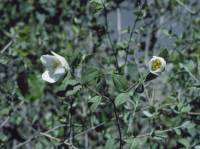Description: Erect shrub 1-2 m tall; leaves opposite, ovate, ovate-lanceolate or narrowly elliptic, margins entire, 10-35 mm long, 4-17 mm wide, glabrous or glabrescent above, sparsely villous hairy below, petiole about 2 mm long; flowers usually solitary (rarely 2 or 3) at the end of a short shoot 2-4 cm long with 2-4 pairs of leaves; calyx tube forming a cup (hypanthium); pedicels, hypanthia and sepals covered in dense tomentum of short, woolly hairs and longer, straight hairs; sepals 4; petals 4, white, 1.2-2.2 cm long, 0.7-1.8 cm wide; corolla cruciform, 2.2-4.2 cm across; stamens about 55, filaments fused into bundles; style and hypanthium disk glabrous; each seed long-tailed. Flowers June to August. Similar Species: The hypanthium and sepals of Philadelphus microphyllus var. microphyllus are glabrous or only sparsely hairy at the base.
Common Name: silvercup mock orange
Duration: Perennial
Nativity: Native
Lifeform: Shrub
General: Shrub to 2 m tall, twigs brownish villous.
Leaves: Opposite, ovate to elliptic or ovate lanceolate, 10-35 mm long, obtuse at base, acute to obtuse at apex, glabrous on upper surface, villous beneath, but barely so, on whitish petioles.
Flowers: Sepals ovate-lanceolate 7-8 mm long, densely lanate, acuminate, petals ovate-oblong, 15-17 mm long, rounded to emarginate at tip, from woolly floral cup, the filaments united into groups.
Fruits: Capsule broadly oblong 10-12 mm long and about 8 mm wide.
Ecology: Found in forested areas and woodlands from 6,000-8,000 ft (1829-2438 m), flowers June-August.
Distribution: Ranges across several isolated mountain ranges in southern Arizona and New Mexico.
Notes: This is considered a rare and endemic species. Powell 1998 indicates this may be synonymous with P. crinitus and is closely related nonetheless. Frazier 1999 again places this species as a subspecies of P. microphyllus, indicating that the distinction is the hypanthium hairs are matted more uniformly with some longer protruding hairs. This entire genus is in need of phylogenetic work. Arizona collections of this species are rare and very old, the most recent being from 1940. There was a single collection made at Saguaro NP in 1909 near Spud Rock.
Ethnobotany: Specific use of the species uknown, however the genus Philadelphus was widely used to make spear tips and arrows.
Synonyms: Philadelphus microphyllus subsp. argyrocalyx
Editor: SBuckley, 2011
Etymology: Philadelphus is a Greek-derived name after Ptolemy Philadelphus, Greek King of Egypt 309-247 BC, and agyrocalyx is a combination of the suffix "argyro" meaning silvery, and calyx, meaning calyx.




